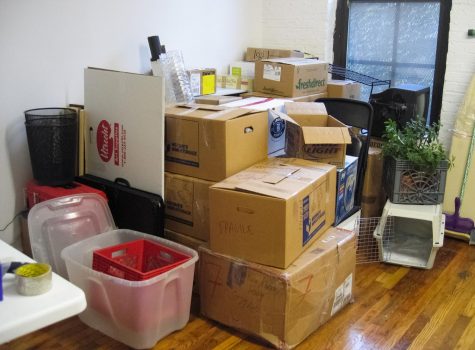The need to knead: a sourdough story
April 29, 2015
When I first started writing these columns, they were meant to always have some sort of science injected into them.
This being most likely my final piece as I’m graduating (finally), I want to talk about a rather complex topic that is something I’ve become very passionate about over the last few years: bread.
Great bread is something of a wonder. While sliced white was a great invention for sandwich construct in terms of durability, being portable, and of course never seeming to go bad, it is inherently bad-tasting bread and just as poor in terms of nutrition.
Now, I don’t want to sound like one of those people you see on BuzzFeed or poorly-cited Facebook posts in which someone starts harping about GMOs or high fructose corn syrup. Yes, mono-triglyceride might seem like a scary sounding ingredient, but it’s just a fatty acid used as a preservative. Thank you, food chemistry.
That being said, what these ingredients in commercially-produced bread say to me is that they are soulless and boring. Great bread has a certain life to it, partly because there’s microbial life before baking, but it also shouldn’t last for more than a week in your cupboard.
My two roommates currently have between them a rather independent fish, a dog and a cat that are rather needy, demanding a pet on the head or stroke on the back every other minute. My pet is my sourdough – resilient, low maintenance, never runs away, has remarkable regenerative properties, and one you can actually eat.
Before microbiologists figured out techniques to cultivate yeast for commercial purposes, humans had been making bread with sourdough cultures for millennia. Without sweeping further into hyperbolic prose, this is a far better way to make and eat bread.
A sourdough culture is essentially composed of flour, water and your friendly neighborhood microbes found in the air that we breathe. A small amount of starter mixed in with more flour, water and salt will yield a loaf with a flavor far superior from any supermarket bakery.
This is due to the complex mix of those wild microbes that each have slightly different sensory characteristics. The sour flavors generally come from the production of lactic and acetic acids during its fermentation metabolism, whereas aromatic compounds are produced by esters, a group of chemicals responsible for many smells.
As time goes by and your sourdough gets older, these flavors will continue to mature and develop, becoming stronger and more persistent as the years go on. A sourdough culture can live basically forever – San Francisco sourdough is more than a century old and still produces really great bread.
Pullman sourdough from my experience isn’t as sharp as what they get in California. Part of it is age, but also the microbes in the air can be vastly different from one place to the next. In fact I like to think that my sourdough is specifically the 615 SE Steptoe sourdough.
So you want to cultivate your own starter. It does take a little time but isn’t hard. In a bowl or a container, mix vigorously to incorporate as much air as you can equal quantities by weight of all-purpose flour and water (200g each).
After about a day or two you should see bubbles forming (carbon dioxide i.e. yeast fart) on the surface, an indication that your microbes have found a new home they’re happy with. Throw out half of this mix and replenish with the same quantities of flour and water (so 100g of each). Essentially you want to keep the ratio of flour and water 1:1 for maintaining your starter.
Keep on refreshing your starter again like this for the next few days until you see a real vigorous rise when you feed them. When healthy, it should ferment to almost double the volume in about two hours and be ready to use at this point.
When not using it, keep it in the fridge, which is essentially hibernation. They are really sturdy creatures and can go for a few months without being fed and still be happy. Well, maybe slightly cranky at the neglect. But simply take them out, feed it again through a couple of cycles and bake as you would.
That being said, making a starter from scratch takes some time and if impatient, ask around for someone to donate part of their starter to you where you just simply need to feed it. Yes, I am more than happy to give my starter to anyone that wants it.
When you do bake your bread, play around with your flour. It should mostly contain plain bread flour (different from all-purpose with its higher protein content) as it gives it the best structure. Although whole wheat can impart a better flavor but can cut the gluten strands holding up your bread.
Finally, like any cherished pet, give it a name. I find it most endearing to say that Yeastiusmaximus produced a particularly sour loaf this week.
BASIC SOURDOUGH LOAF
Start to finish: about a week if developing your starter from scratch, but about an hour of active work in total over 6-7 hours.
Yield: one loaf
311 g bread flour (you can substitute about 20 percent with whole wheat for a nuttier flavor)
20 0g sourdough culture
170 g water
3 g active dry yeast (optional, will give a better rise but flavor isn’t as good)
8 g salt
In a big bowl, mix everything except the salt. It will be sticky. Cover the bowl lightly and leave for 30 minutes at room temperature. Replenish your sourdough, remembering to mix everything vigorously. Set aside as you do everything else and put back into the fridge when it’s active again.
Add in your salt and knead until you pass the window pane test (Google what it looks like). This indicates that your bread has developed its gluten. Kneading shouldn’t take more than 15 minutes by hand or 6-8 minutes on low with a stand mixer.
Transfer to a lightly-oiled bowl. Stretch and fold your dough every 30 minutes for the next two hours (again, Google). What this does is allow your gluten strands to relax and then be better stretched for more structure as opposed to just plain kneading. It can also help recover dough that’s been overworked.
Transfer again to another bowl or a loaf pan that’s been greased and floured. Lightly cover and bulk proof for another 2 hours where it should rise at least by 50 percent.
Your dough is ready to bake at this point, but for an even more pronounced sour flavor, transfer to the fridge and let it develop further overnight before baking.
To bake, set your oven at 425 F. Put an oven-proof pan at the bottom and get some water on the boil. When your oven is at temperature, transfer the loaf pan into the oven, or if you bulk proofed it in a bowl, into a Dutch oven. Score your bread with a sharp knife however you like.
Pour your hot water into the bottom pan, being careful not to burn yourself with the steam – this is essential for getting that really crackly rustic crust.
Bake for 40 minutes. When done, cool it on a wire rack and wait at least 2 hours before you cut into it. The bread needs to rest, if you cut it open now too much, steam will be lost resulting in a dry product.
Sniff in that glorious bread air around you, admire your loaf, and pet your sourdough.





















